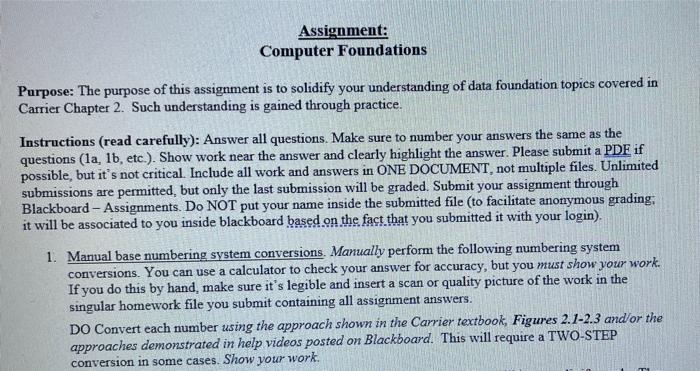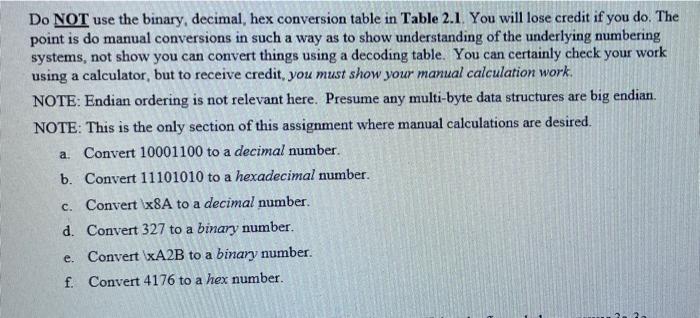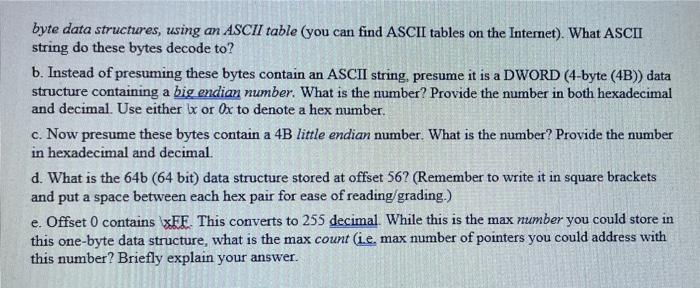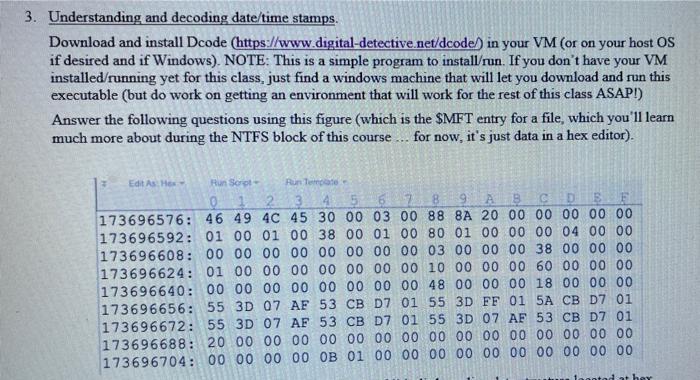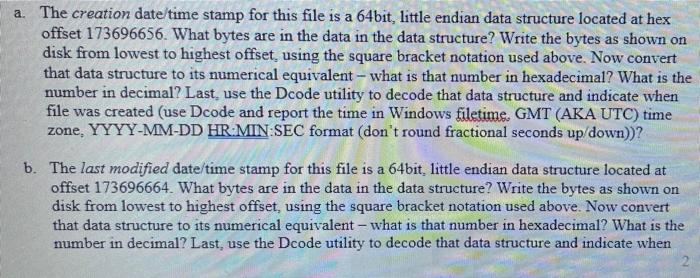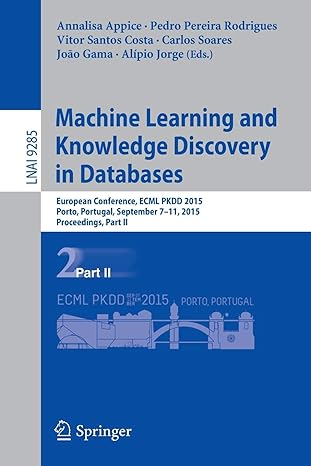Assignment: Computer Foundations Purpose: The purpose of this assignment is to solidify your understanding of data foundation topics covered in Carrier Chapter 2. Such understanding is gained through practice. - Instructions (read carefully): Answer all questions. Make sure to number your answers the same as the questions (1a, 1b, etc.). Show work near the answer and clearly highlight the answer. Please submit a PDF if possible, but it's not critical. Include all work and answers in ONE DOCUMENT, not multiple files. Unlimited submissions are permitted, but only the last submission will be graded. Submit your assignment through Blackboard - Assignments. Do NOT put your name inside the submitted file (to facilitate anonymous grading: it will be associated to you inside blackboard based on the fact that you submitted it with your login). 1. Manual base numbering system conversions. Manually perform the following numbering system conversions. You can use a calculator to check your answer for accuracy, but you must show your work. If you do this by hand, make sure it's legible and insert a scan or quality picture of the work in the singular homework file you submit containing all assignment answers. DO Convert each number using the approach shown in the Carrier textbook, Figures 2.1-2.3 and/or the approaches demonstrated in help videos posted on Blackboard. This will require a TWO-STEP conversion in some cases. Show your work. Do NOT use the binary, decimal, hex conversion table in Table 2.1. You will lose credit if you do. The point is do manual conversions in such a way as to show understanding of the underlying numbering systems, not show you can convert things using a decoding table. You can certainly check your work using a calculator, but to receive credit, you must show your manual calculation work. NOTE: Endian ordering is not relevant here. Presume any multi-byte data structures are big endian. NOTE: This is the only section of this assignment where manual calculations are desired. a. Convert 10001100 to a decimal number. b. Convert 11101010 to a hexadecimal number. c. Convert x8A to a decimal number d. Convert 327 to a binary number. e. Convert \xA2B to a binary number. f. Convert 4176 to a hex number. 2. Understanding and applying endian ordering to decode data. Using the figure below, answer 3a-3e. Edit As Hex Fun Sort Run Time A D E 0: FF D8 FF E0 00 10 4A 46 49 46 00 01 01 01 01 20 16: 01 20 00 00 FF E2 OC 58 49 43 43 5F 50 52 45 46 32: 49 4C 45 00 01 01 00 00 OC 48 4C 69 6E 6F 02 10 48: 00 00 6D 6E 74 72 52 47 42 20 58 59 5A 20 07 CE a. At offsets 6-9, you find the following bytes: [4A 46 49 46]. (Note: In this class, we will use square brackets to represent hex bytes found on disk in offset order.) Decode these bytes individually, as single- byte data structures, using an ASCII table (you can find ASCII tables on the Internet). What ASCII string do these bytes decode to? b. Instead of presuming these bytes contain an ASCII string, presume it is a DWORD (4-byte (4B)) data structure containing a big endian number. What is the number? Provide the number in both hexadecimal and decimal. Use either lx or Ox to denote a hex number. c. Now presume these bytes contain a 4B little endian number. What is the number? Provide the number in hexadecimal and decimal. d. What is the 64b (64 bit) data structure stored at offset 56? (Remember to write it in square brackets and put a space between each hex pair for ease of reading/grading.) e.Offset 0 contains XFE. This converts to 255 decimal. While this is the max number you could store in this one-byte data structure, what is the max count (i.e. max number of pointers you could address with this number? Briefly explain your answer. 3. Understanding and decoding date/time stamps. Download and install Dcode (https://www.digital-detective.net/dcode) in your VM (or on your host OS if desired and if Windows). NOTE: This is a simple program to install/run. If you don't have your VM installed/running yet for this class, just find a windows machine that will let you download and run this executable (but do work on getting an environment that will work for the rest of this class ASAP!) Answer the following questions using this figure (which is the $MFT entry for a file, which you'll learn much more about during the NTFS block of this course ... for now, it's just data in a hex editor). Edit As Hos Hun Sorot- Run lepote 0 2 62 A DBE 173696576: 46 49 4C 45 30 00 03 00 88 8A 20 00 00 00 00 00 173696592: 01 00 01 00 38 00 01 00 80 01 00 00 00 04 00 00 173696608: 00 00 00 00 00 00 00 00 03 00 00 00 38 00 00 00 173696624: 01 00 00 00 00 00 00 00 10 00 00 00 60 00 00 00 173696640: 00 00 00 00 00 00 00 00 48 00 00 00 18 00 00 00 173696656: 55 3D 07 AF 53 CB D7 01 55 3D FF 01 5A CB D7 01 173696672: 55 3D 07 AF 53 CB D7 01 55 3D 07 AF 53 CB D7 01 173696688: 20 00 00 00 00 00 00 00 00 00 00 00 00 00 00 00 173696704: 00 00 00 00 OB 01 00 00 00 00 00 00 00 00 00 00 they a. The creation date/time stamp for this file is a 64bit, little endian data structure located at hex offset 173696656. What bytes are in the data in the data structure? Write the bytes as shown on disk from lowest to highest offset, using the square bracket notation used above. Now convert that data structure to its numerical equivalent - what is that number in hexadecimal? What is the number in decimal? Last, use the Dcode utility to decode that data structure and indicate when file was created (use Dcode and report the time in Windows filetime. GMT (AKA UTC) time zone, YYYY-MM-DD HR:MIN:SEC format (don't round fractional seconds up/down))? b. The last modified date/time stamp for this file is a 64bit, little endian data structure located at offset 173696664. What bytes are in the data in the data structure? Write the bytes as shown on disk from lowest to highest offset, using the square bracket notation used above. Now convert that data structure to its numerical equivalent - what is that number in hexadecimal? What is the number in decimal? Last, use the Dcode utility to decode that data structure and indicate when file was created (use Dcode and report the time in Windows filetime. GMT (AKA UTC) time zone, YYYY-MM-DD HR:MIN:SEC format (don't round fractional seconds up/down))? 4. Explain what a sector is - how many bytes it typically is and what this data unit is relative to how data is written to, stored on, and addressed on a disk
